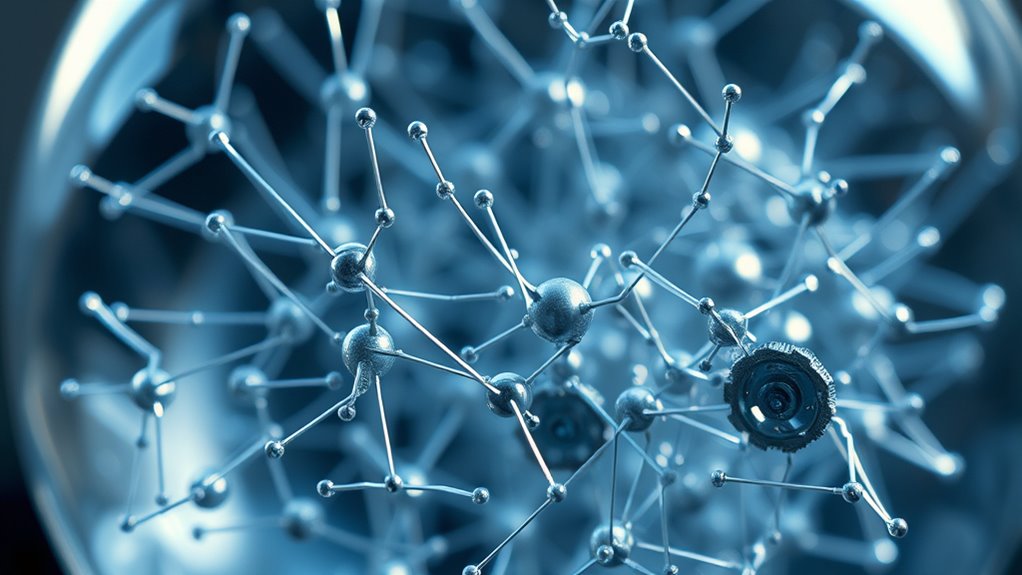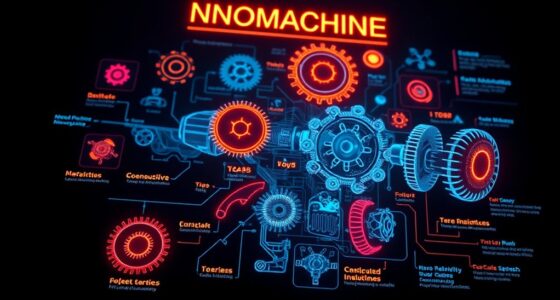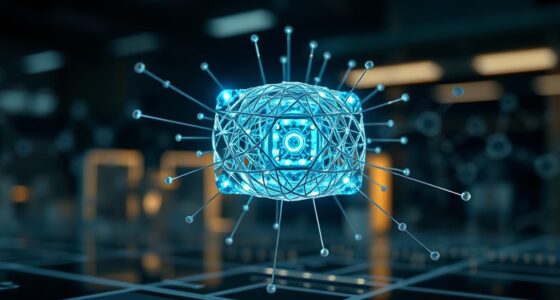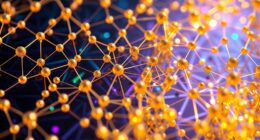Nanomachines work by mimicking natural biological systems to perform precise tasks at the molecular level. They use molecular assembly, where molecules bind, move, or change shape in response to signals, building structures atom-by-atom or molecule-by-molecule. Nanoscale robotics enable these machines to actively move and interact with their environment, such as targeting cells or delivering drugs. To discover more about how these tiny devices operate, keep exploring their fascinating functions.
Key Takeaways
- Nanomachines operate through molecular assembly, building structures atom-by-atom or molecule-by-molecule.
- They mimic biological systems to perform complex, precise tasks at nanoscale levels.
- Nanoscale robotics enable nanomachines to move, interact, and perform functions like targeted drug delivery.
- They respond to signals, binding or changing shape to build or manipulate structures.
- Applications include medicine, where they deliver therapies, repair tissues, or diagnose at cellular levels.
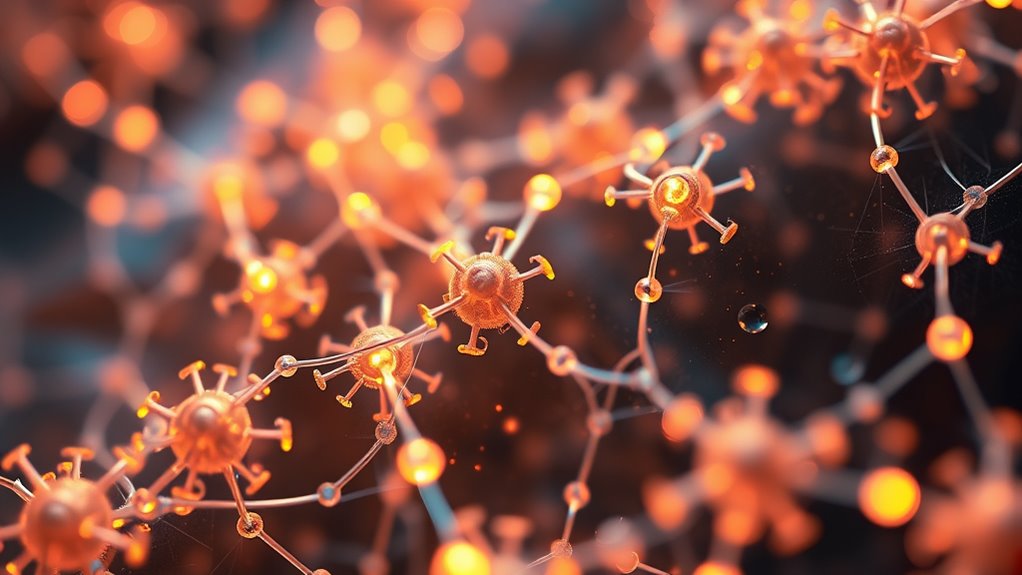
Nanomachines, tiny devices built at the scale of billionths of a meter, are revolutionizing how we approach medicine, manufacturing, and technology. At such a minuscule size, they operate through intricate processes like molecular assembly and nanoscale robotics, enabling functions that were once thought impossible. You might wonder how these microscopic marvels perform complex tasks with such precision. The secret lies in their ability to mimic natural biological systems, where molecules work together seamlessly to sustain life.
Nanomachines mimic biological systems to perform precise, complex tasks at an incredibly tiny scale.
Molecular assembly is at the core of nanomachine operation. Think of it as a highly coordinated construction process, where individual molecules are designed to bind, move, or change shape in response to specific signals. This process allows nanomachines to build structures atom-by-atom or molecule-by-molecule, creating precise configurations necessary for their functions. For example, in medical applications, nanomachines can assemble drug molecules directly at targeted sites within your body, minimizing side effects and increasing effectiveness. This precise control over molecular interactions makes nanomachines powerful tools for targeted therapy, diagnostics, and even tissue regeneration. Understanding nanomachine design is crucial for advancing their capabilities and applications.
Nanoscale robotics takes this concept further by enabling these tiny devices to actively move, manipulate, and interact with their environment. You can imagine nanoscale robots as microscopic workers that can traverse your bloodstream, seeking out harmful bacteria or cancer cells. They can be programmed to perform specific actions—like opening a cell membrane, delivering drugs, or repairing damaged tissues—by responding to chemical signals or physical cues. These nanorobots operate through mechanisms similar to larger robots but are scaled down to manipulate individual molecules or cellular components. Their mobility and precision open up a new world of possibilities for minimally invasive procedures and personalized medicine.
Frequently Asked Questions
What Are the Potential Risks of Nanomachines in Medicine?
You should consider that nanomachines in medicine pose biosafety concerns, such as unintended interactions with healthy cells or immune responses. There’s also the risk of unknown long-term effects, like accumulation in the body or unforeseen toxicity. These potential dangers mean you need thorough testing and regulation to guarantee safe use. Without proper safeguards, nanomachines could cause more harm than good, highlighting the importance of cautious advancement in this technology.
How Are Nanomachines Powered at the Molecular Level?
You might wonder how nanomachines get their power at the molecular level. They utilize molecular energy derived from chemical reactions, such as ATP hydrolysis, to generate nanoscale power sources. These tiny energy sources enable nanomachines to perform tasks like targeted drug delivery or repairing cells. By harnessing molecular energy, nanomachines operate efficiently on a minuscule scale, making them powerful tools for medical and technological advancements.
Can Nanomachines Repair DNA Mutations?
Yes, nanomachines can perform DNA correction and mutation repair. You can imagine them as tiny surgeons that identify damaged or mutated DNA segments, then precisely manipulate or replace faulty parts. They actively scan the genome, detect errors, and carry out mutation repair at the molecular level. This targeted approach helps prevent genetic diseases and could revolutionize medicine by enabling highly specific, efficient DNA correction in living cells.
What Are the Ethical Concerns Surrounding Nanomachine Use?
You should consider that nanomachine use raises significant bioethical debates and privacy concerns. As you explore their applications, you might worry about how personal data is protected or misused. Ethical dilemmas include potential misuse for surveillance or altering human biology without consent. It is crucial to stay informed and advocate for regulations that ensure responsible development, minimizing risks while maximizing benefits for society.
How Do Scientists Ensure Nanomachines Don’t Malfunction?
You can trust scientists to guarantee nanomachines don’t malfunction by focusing on molecular integrity and fault tolerance. They design these tiny devices with robust materials and incorporate error-correcting systems that detect and fix issues in real-time. Rigorous testing and simulations help identify potential failure points, allowing improvements before deployment. This careful approach minimizes risks, ensuring nanomachines operate reliably and safely within their intended applications.
Conclusion
Now that you understand how nanomachines work, you can appreciate their incredible potential. Did you know that researchers estimate there could be over 1 billion nanomachines in a single liter of fluid? That’s enough to perform complex tasks at a microscopic level, transforming medicine and technology. As these tiny machines continue to evolve, you’ll see amazing innovations that could change your life in ways you never imagined. The future of nanomachines is truly exciting!
